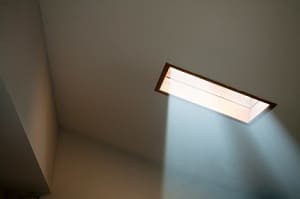 If you’re designing or modifying a home for energy-efficient lighting, it’s important to consider ways to ensure that you get the quality of lighting you’re looking for as well as an expected reduction on your residential electric bill.
If you’re designing or modifying a home for energy-efficient lighting, it’s important to consider ways to ensure that you get the quality of lighting you’re looking for as well as an expected reduction on your residential electric bill.
There are several design principles and methods for using artificial lighting to achieve effective and efficient indoor and outdoor illumination for your home. But you should also consider incorporating the principle of daylighting, which uses windows and skylights to increase the natural light in your home so you don’t have to rely as much on artificial lighting during the day.
Although daylighting faced problems in the past because energy-inefficient windows and skylights contributed to both heat gain and energy loss ” and created other issues, such as paints and fabrics that faded from direct sunlight ” advances in energy-efficient windows and lighting design have turned daylighting into a viable and affordable natural-lighting solution.
The Key Principles Behind Daylighting
There are several key principles to designing or modifying a home for effective daylighting:
– Base your daylighting decisions on utility, not aesthetics. The sizes and locations of windows should be based on the cardinal directions instead of how they make your house look from the street.
– South-facing windows are best for quality daylighting and for moderating seasonal temperatures. South-facing windows allow the most winter sunlight into the home but little direct sunlight during the summer, which limits heat gain during warm months while increasing heat gain during cold months.
– North-facing windows are best for admitting relatively even a sunlight and producing little glare. They also do the best job of limiting unwanted solar heat gain during the hot summer months.
– East- and west-facing windows are the least effective choices when it comes to daylight. While they provide quality light in the morning and evening, they also allow significant solar heat gain during warm months and contribute little to solar heating during cold months.
Daylighting Can Reduce Your Monthly Electric Bills
It’s one thing to say that daylighting can reduce monthly expenses by lowering your electric bills, but it’s another thing to be able to prove it. That’s why the Energy Center of Wisconsin conducted an experiment on daylighting at the Energy Resource Station in Ankeny, Iowa.
The experiment measured commercial HVAC (heating and cooling) energy use in two different buildings one that incorporated daylighting principles (the test building) and one that didn’t (the control building). The experiment simulated three different seasons summer, fall, and winter, and found that daylighting produced significant annual savings per square foot in the test building:
Lighting Savings: 32 Percent Annual lighting costs were 15 cents per square foot in the test building, compared with 22 cents per square foot in the control building.
Cooling Savings: 25 Percent Annual cooling costs were 14 cents per square foot in the test building, compared with 19 cents per square foot in the control building.
Heating Savings: -1 Percent The only recorded energy increase in the experiment was with heating costs, but, at -1 percent, was easily overshadowed by decreases in the other categories. Annual heating costs were 6.1 cents per square foot in the test building, compared with 6 cents per square foot in the control building.
HVAC Fan Energy Savings: 3 Percent The annual energy use for HVAC fans was 12.7 cents per square foot in the test building, compared with 13 cents per square foot in the control building.
Demand Charges Savings: 24 Percent Annual demand charges were 41 cents per square foot in the test building, compared with 53 cents per square foot in the control building.
Total Savings: 22 Percent Overall, the annual HVAC use cost $0.89 per square foot in the test building, compared with $1.13 per square foot in the control building.
Although many residential electric customers don’t pay demand charges, in which electric companies charge more for electric use during peak demand, the demonstrated lighting and cooling savings achieved through proper daylighting are significant enough that homeowners should consider incorporating daylighting principles in new home construction or as a home improvement project.
Sources
Energy Savers website, Daylighting.
Daylighting Collaborative website, Why Daylight?
Energy Center of Wisconsin report, Energy Savings from Daylighting: A Controlled Experiment, May, 2005.



